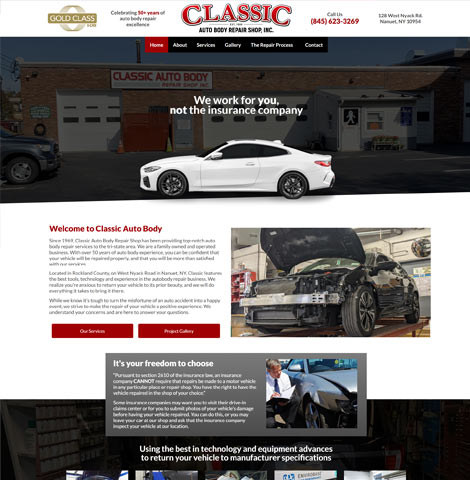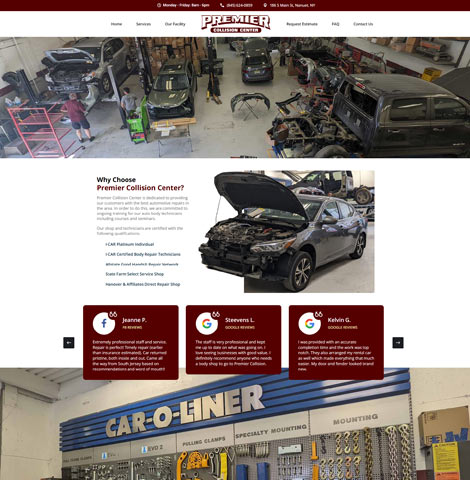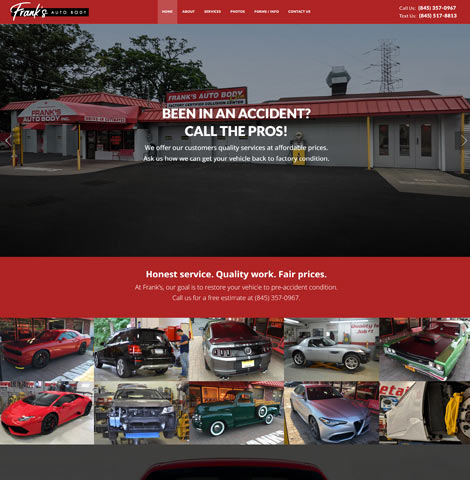Nothing convinces potential customers more than real success stories especially when it comes to your website. Auto body shops that invest in website makeovers often see dramatic improvements in traffic, leads, and bookings. Here are inspiring before and after examples of collision repair websites that transformed their online presence and reaped the benefits.
Case Study 1: From Outdated to Outstanding
Before: A cluttered homepage with tiny text, no mobile support, and no appointment system. Visitors struggled to navigate, resulting in few inquiries.
This auto body shop had a website that hadn’t been updated in years. The homepage was filled with too much information crammed into small spaces. Fonts were hard to read, especially on mobile screens, and images took too long to load. There was no way to book an appointment online, forcing customers to either call or give up. Most visitors would land on the page, look around for a few seconds, and leave leading to almost zero engagement. Even the contact information was buried in a menu that didn’t work well on smartphones, making it frustrating for people who needed help quickly. The first impression the site gave was confusion and inconvenience, not professionalism.
After: A sleek, modern design featuring mobile responsiveness, a clear “Request Estimate” button, and a gallery of before and after repair photos.
Once the site was rebuilt with a modern layout, the experience completely changed. Now, whether customers visited from their phone or desktop, everything was easy to read and fast to load. Visitors were greeted with a clean design that highlighted key services, showcased a portfolio of repair work, and guided users to a clear action requesting an estimate. Adding visual proof of past work helped potential clients feel more confident, as they could see the transformation of damaged vehicles into factory finish results.
Result: Website traffic increased by 70%, and online appointment bookings doubled within three months.
Within a short period, the difference was measurable. More people visited the site and, more importantly, stayed on it. The streamlined layout and added visuals encouraged users to explore and engage. With appointment requests available directly on the site, conversions grew rapidly turning what was once a dead-end online presence into an active lead generator.
Case Study 2: Adding Trust and Transparency
Before: Minimal contact info, no reviews, and outdated photos. Visitors questioned the shop’s credibility.
This shop’s original website gave little information and almost no reassurance to visitors. The contact section was limited to just a phone number, and the imagery included low-resolution, years-old photos of the garage. There were no testimonials, no links to social media, and no indicators of professionalism or trust. For a customer facing a stressful situation like dealing with a wrecked car the lack of information left them unsure if this was a legitimate business they could rely on. Many would bounce off the site and continue searching for a shop that felt more trustworthy.
After: Integration of customer testimonials, trust badges for certifications, and an embedded Google map. A new blog section was added to share repair tips.
After the makeover, the site clearly communicated who they were and what they stood for. Real customer testimonials were added, giving visitors first-hand insight into others’ experiences. Trust badges such as I-CAR Gold Class and insurance partner logos were included to instantly build authority. The embedded Google Map made the business feel more local and accessible. A simple blog also helped highlight common repair topics and answered typical customer questions, showing that the shop cared about educating clients, not just making sales.
Result: Customer engagement improved significantly, with a 50% rise in quote requests and a noticeable boost in positive online reviews.
After these additions, people who landed on the site spent more time reading and interacting. The clear proof of credibility reassured visitors and led to more quote requests through the site. As more customers came in, many left reviews which then further boosted the shop’s online reputation. It became a snowball effect that turned initial doubt into growing trust.
Case Study 3: Streamlining Customer Interaction
Before: Customers had to call to get estimates and schedule appointments, creating delays and missed opportunities.
The previous version of this shop’s website acted more like a digital brochure than an actual business tool. There were no interactive features just static text. If someone wanted to know how much a bumper repair would cost or when they could drop off their car, they had to call the shop during business hours. This process caused delays, especially for people who were browsing after hours or during work. Many potential customers simply didn’t have time to play phone tag or wait on hold. As a result, opportunities were lost, and phone lines became overwhelmed with basic inquiries that could have been handled online.
After: Online forms for estimates and real-time appointment booking were introduced. Live chat support was also added for instant communication.
The updated website included smart, easy-to-use forms where users could submit photos and details for fast estimates. Appointment scheduling became a self-service feature, with available time slots clearly visible. Live chat support gave visitors the option to ask quick questions without picking up the phone. These changes didn’t just modernize the site they changed how the business interacted with people. It opened the door to 24/7 inquiries and made the entire process smoother and more efficient for both the customer and the shop.
Result: The shop reduced phone calls by 30% but increased conversions by 40%, freeing staff for repair work rather than administrative tasks.
With fewer phone interruptions, the staff could focus more on repairing vehicles and serving walk-in customers. Meanwhile, the website worked like a silent assistant collecting leads, scheduling jobs, and answering questions around the clock. The result was a noticeable boost in efficiency and a clear rise in booked work, all thanks to better digital customer interaction.
Conclusion
These real-world transformations show just how much a website makeover can impact an auto body shop’s success. By improving design, trust, and interaction, these shops didn’t just look better online they achieved real growth. A strong digital presence isn’t just a luxury anymore; it’s a key driver of customer engagement. The difference between a visitor and a loyal client often starts with what they see and feel on your homepage.





